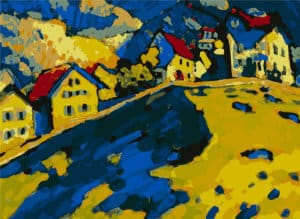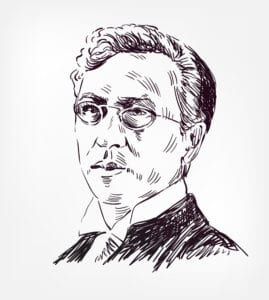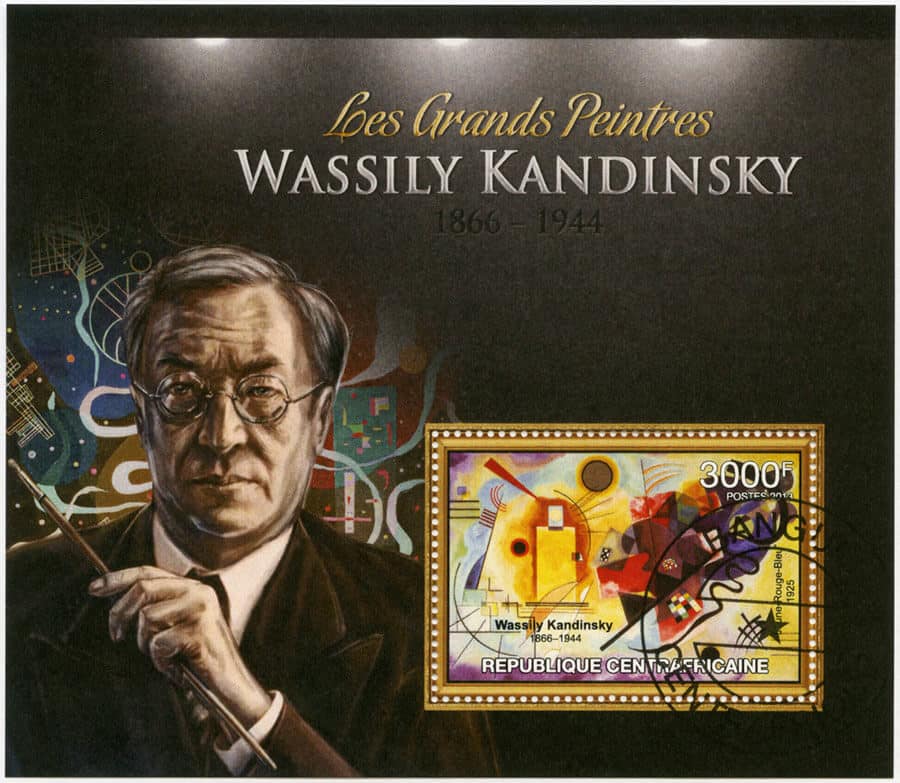What if paintings could sing or play an instrument? The colours and shapes that form a beautiful masterpiece can actually be an orchestral wall of vivid music instrumentation. The condition Synesthesia is not a nuisance, but a true artistic gift. Russian artist, Wassily Kandinsky (Vasyl Kandinsky) proves that this creative condition opens up a world of abstract experimentation and musical enlightenment.

Who was Wassily Kadinsky? As you stare into an exquisite painting or illustration, what sound springs to mind? Have you ever experienced red accents represent by anger or love, practically hopping off the page before you? Can the essence of the colour blood orange portray a summer evening sunset, while hearing the washing of waves? The better question would be, what do you hear when you see these colours? Individuals, such as Russian artist, Wassily Kandinsky, would possibly proclaim that the outer lining of a painted crescent moon in midnight blue would sound like a calming flute.
This is brought on by Synesthesia, a condition that breaks a new barrier for all things creative and artistic.
The Making of Kadinsky

Growing up with a mixed cultural upbringing of Chinese and European, Kandinsky was accustomed to travel as he, and his family, embarked on various travels to Vienna, Rome and the Crimean Peninsula at a young age. In Odessa, young Kandinsky would begin rigorous training through the cello and piano. But playing music was not his only love. The young musician would begin to dabble into the world of paint as a visual artist, which opened up his mind to all this abstraction and color. Even through his university studies of law and economics, the painter would find extreme fondness in Russian folk paintings, preferably non-realistic styles. In 1896, Kandinsky moved to Germany to dive into the world of painting more rigorously.
Influenced by Impressionism and the golden age of Art Nouveau, characteristics of artistic expression such as Neo Impressionism, Expressionism and Fauvism sunk into his vivid inspiration during his time in Munich, Germany.
“Color is the Keyboard; the eyes are the Hammers; the sum is the piano with many strings.
The artist is the hand which plays, touching one key or another, to cause vibrations in the soul” (Kandinsky’s Concerning the Spiritual in Art)
Music and Art Intertwined
The correlation of painting and music has been intertwined for centuries. The expressiveness of colour, shapes and lines depict, what some would say, the essence of abstract art.
Synesthesia is a condition where an individual experiences the act of one sense as a result of experiencing another. This meant, that when the painter heard sounds, he noticed and endured color. When he would see color, he would hear music. For Kandinsky, green conducted the middle notes of a violin. White announced the pauses or breakage of melody. Black is the ending or subtle sweet pauses of the end of a song. Red depicted a harsh trumpet sound. The violet color embodied the essence of wood instruments. From cool red sounding of a sad cello to orange sounding like an angelic crisp of old age violin, color conducted a full orchestra of sounds within his mind. The condition did not cause any problems, but more so an inspiration as the two art forms combined. In his 1911 painting, Impression III (Konzert), the artist illustrates an abstract painting resulting from an experience of a concert led by Austrian composer Arnold Schoenberg.
The painting portrays Kandinsky’s ability to re-animate the coming together of senses, while creating a heavy focal point of abstractness. The artist believed that music was a necessity for all things abstract. He said:“Music has been the art which has devoted itself not to the reproduction of natural phenomena, but rather to the expression of the artist’s soul”.
Creating a Legacy
With his desire to express an inner need or the value of his soul, Kandinsky formed and artist collective, Der Blaue Reiter” which was made to form a community of masterful artist that fuelled on all things experimentation. According to YouTube Channel Listening In, Kandinsky believed that colour was not the only aspect of art that made melodic sounds. According to the artist, colour created boundaries, which formed through existence of a canvas. Colour was not limitless and remained condensed in form of a painting.
Through these paintings, geometric shapes stabilised the blueprint of these styles of artwork. With shapes, there indeed were sounds. For example, triangles embody intrinsic melodies and keep a standard distinct rhythm. Through more complex artwork of shapes, these paintings developed a more complex instrumentation. This was called symphonic paintings or illustrations. Through his understanding of sound, color and shapes the artist embarked on a 19-year creation of 10 paintings entitled Composition I-X. This project was important as its efforts were meant to reach the level of abstraction he felt as an individual with synesthesia. The paintings may seem unrecognisable to some, but if you look closer, various objects such as doors or angels are hazily visible to the naked eye. The most complex of the project is Composition VII.
The painting is a cosmic array of vibrant and sultry dark figures that vary from abstract objects and colourful accents. One may feel as if their eyes are hysterically moving in a frantic motion in order to almost mentally photocopy the image. This action was said by the artist to embody the evolution of music created in orchestral presentation from his fellow musician colleagues.
Composition VIII embodied the pure essence of sounds in form of shapes. This futuristic world of color and experimental lines, form a musical harmony that expresses the coming together of various notes bleeding together in a form of musical interpretation.
So, the next time you are immersed into an illustration or majestic painting, see if you can hear the music of visual art.
Photos: Shutterstock
Need more alternative arts in your life? Check out this article on obscure music:
Support us!
All your donations will be used to pay the magazine’s journalists and to support the ongoing costs of maintaining the site.
Share this post
Interested in co-operating with us?
We are open to co-operation from writers and businesses alike. You can reach us on our email at cooperations@youthtimemag.com/magazine@youthtimemag.com and we will get back to you as quick as we can.










